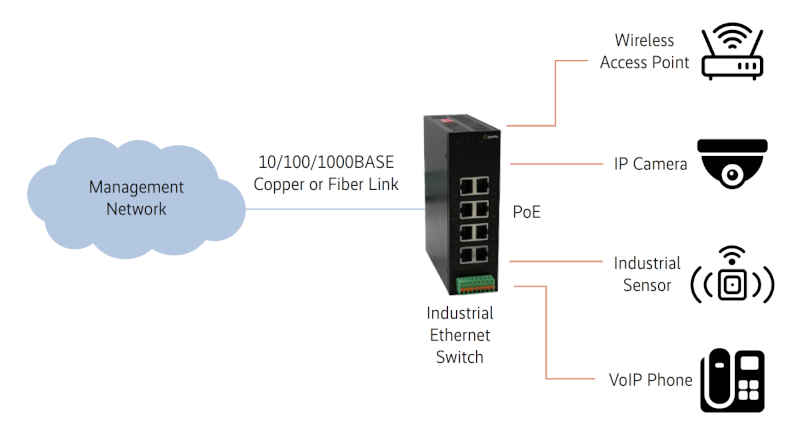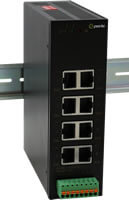PoE Switch IDS-108HP from Perle Systems put to the test
The IDS-108HP from Perle Systems is a PoE Switch that delivers up to 90 watts of PoE power per port. We took a closer look at the compact switch in a detailed test. Originally published in German by iX Magazin here.
By Hubert Sieverding
Power over Ethernet (PoE) is a great thing when you need to place a sensor or WLAN access point in a location where there is no power outlet. With PoE, power is supplied via the Ethernet cable (see illustration).
Power is supplied via the free wire pairs in the Ethernet cable. With gigabit cables, the signal lines can also be loaded. In this case, DC voltage is coupled and decoupled. The typical supply voltage is 48 volts. Depending on the specification, device power can range from just under 13 watts up to, more recently, 100 watts (IEEE 802.3bt-2018, Class 8+).
Given that PoE source equipment does not know if an end device is PoE-capable, a simple load can be destructive. This is why the start-up is carried out in several steps. Detection checks whether the end device has a resistance in the range of 19 to 26 kiloohms. The next step is to increase the voltage until a typical voltage of 48V is reached.
PoE splitters, devices that combine the Ethernet signal with 48 volts DC, serve to supply power to non-PoE-compatible devices. The disadvantage is that a splitter is required for each signal line. If several PoE devices are to be supplied, a PoE Switch is recommended. We tested the Perle IDS-108HP, the entry-level model from the IDS-100HP series.
The compact housing (W 44 × H 145 × D 122 mm) has a DIN rail mount on the rear, [Ethernet] ports, a power connector strip and status indicators on the front, and a row of DIP switches on the top. The device is supplied in a simple cardboard box, without installation instructions or a power supply unit. This will certainly be of benefit to customers wishing to install multiple switches, while others will have to find the instructions on the Internet.
New customers may search for a suitable power supply unit after studying the installation instructions. The only way to find a suitable model is to browse through long tables in the supplier's website. It is advisable to purchase two power supply units as the switch has two redundant connections. The cables are plugged in and not screwed in. If the power supply is not securely fastened, a red status LED will warn you. The switch also has a relay changeover switch which opens or closes an alarm contact if both power supply units are not providing power. The tested model can be used in dry indoor areas in a temperature range between -40 °C and70 °C.
The Perle Switch automatically detects PoE devices and signals this with a separate LED for each port. In our test environment, we connected the gigabit ports of a Dell server (without PoE) to three single-board computers (SBCs): two Raspberry Pi and a StarFive VisionFive 2 with RISC-V. The latter has two gigabit ports, of which one is PoE-capable. In principle, both the Raspberrys and the VisionFive are ideal PoE devices given their limited power consumption. However, they are not PoE-enabled per se, but require an additional PoE HAT* add-on board. From the Raspberry Pi 3B+ onwards, four additional connection pins are available next to the GPIO connector strip.
The PoE HAT draws 48 volts of PoE power and feeds it to the motherboard as 5 volts. The Chinese RISC-V computer has a Raspberry-compatible connector strip and can therefore also be operated with the Raspberry extension.
Unfortunately, the Raspberry Pi 3B we used was not PoE-capable and was therefore supplied via a splitter. These are available online for just a few euros and transmit signals via RJ45 and power via Micro-USB or USB-C. From the PoE Switch's point of view, there is no difference between the two solutions. The MDR-60-48 DIN rail power supply unit we use has a maximum output of 60 watts, making it fully suitable for the PoE end devices used.

Throughput
The throughput of the switch measured with iPerf3 (Raspberry Pi 4 to Dell) is around 940 Mb/s regardless of PoE load. This is exactly the same performance as the TP-Link TL-SG116, a 16-port gigabit switch without PoE support, that wasused for comparison.. Differences can be seen in the power consumption. When idle, the Perle [PoE] Switch consumes a hefty 5.6 watts. Under load from an iPerf3 connection; the [PoE Switch consumes an] average of 6.5 watts. The TP-Link [non-PoE] switch performs significantly better with 2.95 and 3.65 watts respectively. All measurements are gross, i.e. including the 48V power supply, which could be a reason for the Perle PoE Switch consuming almost twice as much power. If the Raspberry Pi 4 is supplied with power from the Perle Switch, the average consumption for pure network traffic with iPerf3 rises to 11.5 watts. When the Pi 4 is connected to a separate power supply (USB charger), the switch and Raspberry use much less power at just under 10 watts. (See the "Power Consumption – SBC Bench" table.)
Power Consumption - SBC Benchmark
| Measurement | Maximum (Watts) | Average (Watts) |
|---|---|---|
| Raspi 4 with PoE on Perle Switch | 13.13 | 11.02 |
| Raspi 4 with own power supply on Perle Switch | 11.62 | 9.37 |
The difference is at the expense of the PoE-HATpo and increases significantly if a very long Ethernet cable is used, with corresponding losses due to the small cable cross-section. This difference can also be seen when the CPU-heavy SBCbench is run. It fully utilises the cores over a longer period of time but does not make use of the network. Here, the Perle PoE Switch and PoE-powered Raspberry Pi 4 together require a maximum of just over 13 watts. If an external USB power supply is used for the Raspi 4, the power consumption of both devices is 11.6 watts. (See the "Power Consumption iPerf3 Benchmark" table.) As typical PoE end devices are usually in continuous operation, consumption from PoE increases quickly as devices are added.
Power Consumption iPerf3 Benchmark
| Benchmark | From... To... | Measurement | Maximum (Watts) | Average (Watts) |
|---|---|---|---|---|
| Idle | -- | Perle Switch | -- | 5.60 |
| Idle | -- | TP-Link Switch | -- | 2.95 |
| IPerf3 | Raspi 4 PoE – Dell Server | Perle Switch | 11.95 | 11.58 |
| IPerf3 | Raspi 4 – Dell Server | Perle Switch, Raspi 4 with own power supply | 10.14 | 9.96 |
| IPerf3 | Raspi 4 – Dell Server | Perle Switch | 6.68 | 6.54 |
| IPerf3 | Raspi 4 – Dell Server | TP-Link Switch | 3.72 | 3.65 |
The Perle PoE Switch is designed for reliable continuous operation. Not only is the redundant power supply exemplary, but the relayalarm control in the event of dual failure is a straightforward solution. Two connections are provided on the power supply connector strip for this purpose, with the option of opening and closing. Perle offers a Watchdog feature that regularly sends signals over the Ethernet cable to PoE end devices (e.g., sensors or security cameras). The ports to be monitored can be selected via DIP switches on the top.
If there is no network traffic via a port within 30 seconds, the switch briefly interrupts the PoE supply, causing the end device to restart. To ensure that the operating system starts up properly, the first check is performed after five or 10 minutes as configured via the DIP switches.. Re-triggering within the 30-second monitoring period is per port. It is important to restart the switch if DIP switch configuration settings are changed.
This control is ideal for SBCs such as the Raspberry Pi, as a hardware reboot can only be carried out by disconnecting the power supply. At first glance the mechanism seems a little clumsy. However, the alternative, namely remote control of the PoE power supply, requires a managed switch and additional monitoring hardware.
In our test, we checked the functional principle with an additional WLAN connection to the end device. As long as data is flowing through the Ethernet cable, the switch will be triggered. If there is no data, the system restarts cyclically after ten and a half minutes at the latest. It is therefore advisable to only monitor PoE consumers that regularly send data, such as sensors or cameras.
Conclusion
With the IDS-108HP, Perle Systems offers a PoE Switch for robust, operationally reliable use. However, depending on the power supply units used and due to its 48-volt supply. The energy consumption is significantly higher than that of comparable [non-PoE] switches.
Data and prices
| Perle IDS-108HP: compact PoE Switch with 8 ports and IP30 or IP40-certified metal housing without fan |
| Equipment: 8 × 10/100/1000BASE-TX ports, PoE Watchdog, mounting for standard 35 mm DIN rail in accordance with DIN EN 60175 |
| PoE power: 90 watts per port, 270 watts power budget |
| Power supply: Dual power supply via external power supply unit |
| URL: https://www.perle.com/products/switches/ids-108hp-8-port-unmanaged-industrial-poe-switch.shtml |
| Price: IDS-108HP (IP30, -10 °C to 60 °C): $653; IDS-108HP-XT (IP40, -40 °C to 75 °C): $705 |
RATING
| Redundant power supply with connected cables |
| Up to 90 watts of PoE power per port with a power budget of 270 watts |
| Switchable Watchdog circuit per port |
| Installation instructions and power supply unit not included |
| Increased power consumption compared to other switches |
| Watchdog DIP switch only accessible from above; not ideal for control cabinet installation |
HUBERT SIEVERDING
works as a freelance author after many years in the automotive industry.
*A PoE HAT (“hardware attached on top”) is a Raspberry Pi accessory.
